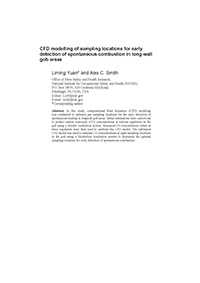Mining Publication: CFD modelling of sampling locations for early detection of spontaneous combustion in long-wall gob areas
Original creation date: January 2012
In this study, computational fluid dynamics (CFD) modelling was conducted to optimise gas sampling locations for the early detection of spontaneous heating in longwall gob areas. Initial simulations were carried out to predict carbon monoxide (CO) concentrations at various regulators in the gob using a bleeder ventilation system. Measured CO concentration values at these regulators were then used to calibrate the CFD model. The calibrated CFD model was used to simulate CO concentrations at eight sampling locations in the gob using a bleederless ventilation system to determine the optimal sampling locations for early detection of spontaneous combustion.
Authors: L Yuan, AC Smith
Peer Reviewed Journal Article - January 2012
NIOSHTIC2 Number: 20041387
Int J Min Miner Eng 2012 Jan; 4(1):50-62
See Also
- Bleederless Ventilation Systems as a Spontaneous Combustion Control Measure in U.S. Coal Mines
- CO and CO2 Emissions from Spontaneous Heating of Coal Under Different Ventilation Rates
- The Critical Ventilation Velocity in Tunnel Fires - A Computer Simulation
- Development and Application of Reservoir Models and Artificial Neural Networks for Optimizing Ventilation Air Requirements in Development Mining of Coal Seams
- Modeling and Prediction of Ventilation Methane Emissions of U.S. Longwall Mines Using Supervised Artificial Neural Networks
- Modeling Carbon Monoxide Spread in Underground Mine Fires
- SPONCOM - A Computer Program for the Prediction of the Spontaneous Combustion Potential of an Underground Coal Mine
- SponCom - Spontaneous Combustion Assessment Software - 2.0
- Study of Mine Fires and Mine Ventilation: Part I, Computer Simulation of Ventilation Systems Under the Influence of Mine Fires
- Technology News 545 - NIOSH Updates Spontaneous Combustion Assessment Software
- Content source: National Institute for Occupational Safety and Health, Mining Program


 ShareCompartir
ShareCompartir
